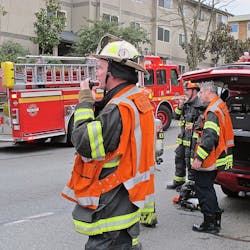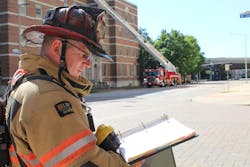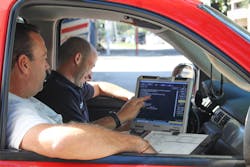Appropriate management of an incident begins with the incident size-up. The information we obtain from dispatch, performing a 360, radio reports from crews already on scene, reading smoke, occupants who are outside waiting our arrival and pre-incident plans all feed the initial size-up and help us develop a mitigation plan.
Someone is going to need to take all this information and work it into a plan that takes into account the tactical and strategic priorities. Although incident command may be passed a couples of times, this article will focus on the individual who will assume a formal command and the options that are available to them in obtaining and processing critical information quickly and decisively to bring about a successful outcome.
IC assignment and position
The position of incident commander (IC) is implemented differently depending on your department and local or regional policies. It could be the first member on scene, the first officer on scene or the highest rank on the first apparatus on scene. We are all aware of what some experts recommend, but we are also aware of what reality presents once on scene and quickly realize the limited effectiveness of “mobile command.” Many organizations weigh the pros and cons, and interpretations vary, but the reality is that command must be established quickly and decisively for optimal crew management and accountability.
Positioning of the command post is important and varies greatly from organization to organization. Do they post up in the front of the building? Do they sit in his SUV down the street? Do they have a dedicated command vehicle? Do they have an aide, or can they get one?
From my experience in my large organization, I believe the IC should be removed from the incident, as far as practical but close enough to sense the scene and consider the need for their aide to act as a runner if needed. This allows the IC to remain in a clean environment free from any distractions.
The IC needs to focus on all the information coming from dispatch, Conditions-Actions-Needs (CAN) reports, roof reports, crew arrival reports, and information provided from their aide. As the incident expands, there will be more information and requests coming from assigned branches, divisions or groups, and a clean environment will facilitate the IC’s ability to listen, extract the pertinent incoming information and make sound educated decisions to apply to the overall incident action plan (IAP).
A good IC will not have their mind made up about any one tactic or IAP. It will be as fluid and ever-changing as the incident itself, based on the incoming information obtained from officers assigned to those branches, divisions or groups. The incident could be so big and complex that the IC has offensive operations taking place in one division and defensive operations taking place in other divisions. It could also be so small that it warrants only a limited use of the incident command system. It is important that the IC receives, understands and bases their decisions on the information coming from those company officers assigned to those divisions.
Scene size-up and preplans
If an aide or chief’s driver is available, the IC who is still en route should be documenting on their worksheet or mobile data terminal (MDT), so they know what orders have already been given once they arrive, all to maintain ongoing accountability and track the location of companies and their functions.
As part of their ongoing size-up, and possibly from a distance, the IC can monitor the fire conditions, smoke conditions, the effects of any weather conditions and the effect that fireground operations are having on the incident. Once on scene, the IC can also request that their aide or another company on scene perform another 360 to provide an updated report of conditions and exposure problems.
Preplans are another vital tool available to the IC to help with size-up and a fluid IAP. Most early-arriving companies should have access to preplans, but not necessarily the time for a thorough review. For the IC, the preplan, if recorded and entered properly, includes most aspects of the building they need to know. It can include contact numbers, construction type, fire protection systems and their classifications, utilities and hazards, square footage, roof access, hydrant locations and sizes. It could also include HVAC operations for ventilation in high-rise buildings if deemed necessary. Preplans can be as detailed as your department deems necessary.
Technology and software
Many departments have preplans on paper, stored on apparatus and command vehicles. With the increased use of tablets or MDTs in apparatus and command vehicles, this same information can be included as part of the initial dispatch information and easily accessed in a digital format. Software programs make it as simple as opening another page on the tablet or MDT.
A variety of programs are available, some limited to one or more function while others are all-inclusive and can even generate a final report. Some of these programs are available for the phone apps, tablets and MDTs.
Programs can offer real-time mapping and location by GPS and the tracking of companies and their assignments throughout the incident. Some provide for accountability by individual names and company assignment, air consumption, heat exposure alarms, monitor PASS devices, and even send audible alarms and receive acknowledgements from firefighters regardless of where they are on the fireground.
Additional features include an online tactical worksheet, preplans of target hazards in your area, including photos and satellite imagery, the Department of Transportation Emergency Response Guide (DOT ERG), benchmarks and timers, and some even allow you to add resources during an incident. Even more, some software programs can be matched to an individual department’s standard operating procedures and guidelines (SOPs/SOGs), making for a custom fit.
Some accountability programs can send specific alert tones advising crews to evacuate or give a personnel accountability report (PAR). These same programs allow for acknowledgement from the crews, providing for an immediate and timely response and meeting a critical benchmark without creating additional radio traffic so prevalent on the fireground.
Some SCBA manufacturers are getting in on the accountability market as well, offering the same options incorporated into their remote pressure gauge. Your options will depend on the program or software you choose. Some require more active participation from the user than others, some offer limited ability compared to others, and some require that you use certain SCBAs or additional tablets and MDTs.
Before jumping on any one program, I recommend thorough research to see what fits your department now and in the future. Some of these software programs allow you to account for and track members just like you would with a grease pen or pencil, only you simply open a screen, click and drag or turn on a bottle. This is convenient; however, some programs may require commitment, training and 24/7 support to be a reasonable option. This can be a costly option in comparison to the dull pencil or grease pen.
The newest, most overlooked and under-appreciated tool available to the IC for size-up is the drone. Drones can offer an ongoing 360 degree and vertical size-up for the entire incident, without committing additional company resources to that task. Consider the amount of unnecessary radio communications that can be removed from the fireground with this one option.
Imagine the chief’s aide getting a drone in the air early in the event and being able to tell the company assigned to roof operations on a mid-rise which stairwell to utilize or that they will be dealing with an H-style roof, open shafts, heavy static loads, etc. Using a thermal-imaging camera, it could even show the fire location before crews reach it. What’s more, think about the image the IC would get when the drone clears the top of a three-story flat roof and discovers that the building that shows to be 50 feet wide on the A side expands to 200 feet on the C side. This is crucial information in the early stages of a working fire.
IC priorities
If there is only one room that has no fire coming from it and an officer advises that conditions in that room are tenable, the IC should commit the crew to initiate vent-enter-search (VES) of that one room while taking into account what the rest of the scene presents. The interior door to that room may be closed or can be quickly closed. The victim may be on the floor, under the window and not quite in the flow path.
The IC needs to understand that in this situation, the request to search will likely come from a crew that trains and is competent in that function, not one that is half-hearted in their efforts and expertise.
Final thoughts
The size-up for a later-arriving commanding officer can be very different than the early-arriving company officer. The early-arriving IC will need to piece together their size-up based on initial radio reports as well as dispatch and preplan information to get the overall picture of what they are facing. The IC’s job can be made easier by looking at what technology has to offer as well.
ICs should be competent and experienced members of your organization. They should also be good listeners. They must know how to listen to the information coming from first-line officers, and they should know the ability (or lack of ability) of each crew for which they are responsible. This knowledge will make for easier decision-making on high-risk tactics or requests.
Of all the optional aides available—printed, digital or airborne—the IC’s greatest asset is their ability to listen first, then act.
Sidebar: Acronyms for the IC
The following are the acronyms that have been around for many years and can be added to any worksheet, tablet or MDT, for easy access by the IC.
RECEO-VS
R - Rescue
E - Exposure
C - Confine
E - Extinguish
O - Overhaul
V - Ventilate
S - Salvage
SLICERS
S - Size-up
L - Location of fire
I - Isolate
C - Cool from safe distance
E - Extinguish
R - Rescue
S - Salvage
COAL-WAS-WEALTH
C - Construction
O - Occupancy type
A - Area (size)
L - Location and extent of fire
W - Water supply
A - Apparatus and equipment
S - Street conditions
W - Weather
E - Exposures
A - Auxiliary appliances
L - Life
T - Time
H - Height
About the Author

Chris DelBello
Chris DelBello is a 29-year veteran of the fire service, with 20 years with the Houston Fire Department, currently holding the rank of senior captain, assigned to Ladder 7 in Midtown. He is the district training officer for District 8, which includes all of downtown Houston and surrounding companies. DelBello holds a Training Officer l certification. He also hosted a high-rise conference in March 2018. Learn more at midtownmayhemllc.com.



